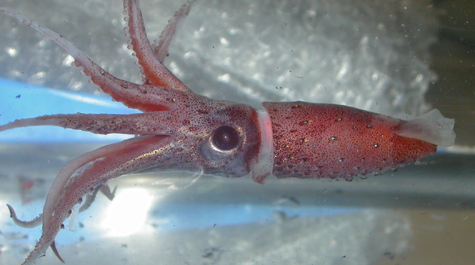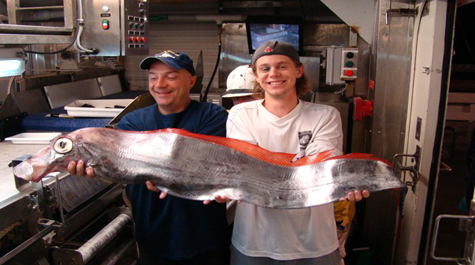VIMS professor asked to help announce Census of Marine Life findings
The Census is an unprecedented collaboration among researchers from more than 80 nations to assess and explain the diversity, distribution, and abundance of life in the oceans. During the last decade, the 2,700 scientists involved in the Census have mounted 540 expeditions, identified more than 6,000 potentially new species, cataloged upward of 28 million distribution records, and generated 2,600 scientific publications.
The Census not only advances knowledge about life in the global ocean, including the first ever complete catalog of marine life, but will serve to inform decisions about how to best manage the world's marine resources.
Sutton will represent two Census projects—the Mid-Atlantic Ridge Ecosystem Project (MAR-ECO) and the Census of Marine Zooplankton—during Monday's news conference and a subsequent 2-day scientific symposium. Both events will be held in collaboration with National Geographic.
VIMS adjunct professor Michael Vecchione, a MAR-ECO scientist and member of the MAR-ECO steering committee, will also attend the London events. In addition to his role in MAR-ECO, Vecchione has been involved in Census projects in the Arctic and Antarctic, exploring seamounts, and synthesizing information from the deep sea.
In total, the Census comprised 14 field projects designed to cover the major habitats and groups of species in the global ocean. Eleven field projects addressed habitats such as coral reefs or the Arctic Ocean. Three field projects looked at long-distance migrators like tuna or globally distributed species such as microbes. Other projects focused on development of new technologies for studying the ocean and for managing ocean data.
In addition to Sutton and Vecchione, several other VIMS researchers have been involved in Census of Marine Life projects. Professor Bob Diaz took part in a 2007 study of biodiversity in the deep waters of the Southern Ocean off Antarctica. Professor Deborah Steinberg has been involved in a long-term project to record the diversity of zooplankton in the Sargasso Sea south of Bermuda. Her efforts are part of a Census-related U.S. initiative to create an on-line database of marine animal and plant distributions called the Ocean Biogeographic Information System.
VIMS graduate students and technicians—April Cook, Joe Cope, Chip Cotton, Jeanna Hudson, CJ Sweetman, and Stephanie Wilson—have also worked on Census projects, in addition to dozens of students from various countries.
MAR-ECO
In the Mid-Atlantic Ridge Ecosystem Project, scientists from 16 nations studied deep-sea animals along the underwater mountain range that runs from Iceland to the Azores. During cruises in 2003, 2004, and 2009, Sutton and colleagues used trawl nets and other gear to collect samples from waters as deep as 9,000 feet. The 2004 expedition alone returned with more than 80,000 biological specimens—from bacteria to deep-sea fish—and a vast database of physical recordings that will take years to analyze. One highlight was discovery by Vecchione’s group of several new species of deep-water octopods and squid.During MAR-ECO, Sutton worked with colleagues from a number of different institutions to study the flow of energy through the North Atlantic ecosystem. “Understanding the dynamics of deep-sea food webs is essential for scientific understanding and management of Earth’s largest ecosystem,” says Sutton. “MAR-ECO provided new information about ‘who’s eating whom’ in the deep sea, and the ecological forces that shape ocean communities.” Funding for the multi-investigator project came from the Census and the National Science Foundation.
Sutton notes that an understanding of deep-sea food webs will become increasingly valuable as human exploitation of the sea—via commercial fisheries, oil exploration and production, mining, and other activities—moves into ever-deeper waters.
Census of Marine Zooplankton
The Census of Marine Zooplankton is another Census field project. Project scientists, who hail from 39 countries around the world, studied the 7,000 described species of “holozooplankton”– animals that drift with ocean currents throughout their lives. They also identified new species gathered during more than 80 research expeditions and several long-term monitoring programs.A key goal of the project is to generate a DNA barcode for each known species of zooplankton. Sutton says “Knowing which species are out there, and how they’re currently distributed, will help us to detect and monitor how zooplankton populations might change in light of global warming and human activities like fishing.” Zooplankton serve as the base of the marine food web.
Value of the Census
Sutton says the value of projects such as the Census of Marine Life has been demonstrated in many ways. As an example, he cites the discovery that a group of deep-sea fishes previously classified into three separate families are actually the larvae, males, and females of a single family—the whalefishes.“This was a long-standing conundrum in deep-sea biology,” says Sutton, “one that researchers such as David Johnson and John Paxton had been investigating for decades. Census collaboration provided a venue in which key data were used to solve this and other mysteries in the deep sea.”
In a prelude to next week's activities, the national and regional committees of the Census earlier this year compiled an inventory of known and new species in 25 key marine regions. This landmark collection of papers and an overview synthesis will help guide future decisions on exploration of still poorly-explored waters, especially the abyssal depths, and provide a baseline for still thinly-studied forms, especially small animals.
Support for the Census of Marine Life comes from NOAA, NSF, and other government agencies in the U.S. and abroad, private foundations, and corporations. Major support was provided by the Sloan Foundation, including a series of grants through VIMS to the Norwegian Institute of Marine Research. The Census is coordinated by a Secretariat based at the Consortium for Ocean Leadership in Washington, D.C. and governed by an international Scientific Steering Committee.
















